Indesit IDL 55 EU .2 User Manual [ru]

IDL 55
Lavastoviglie
Installazione e uso
Dishwasher
Installation and use
Lava-vasseille
Installation et emploi
Geschirrspuler
Installations und Gebrauch
Vaatwasser
Installatie en gebruik
Lavavajillas
Instalación y el uso
Máquina de lavar louça
IInstalação e o uso
IDL 55
Lavastoviglie |
1 |
Istruzioni per l'installazione e l'uso |
|
Dishwasher |
11 |
Instructions for installation and use |
|
Lave-vasseille |
21 |
Instructions pour l'installation et l'emploi |
|
Geschirrspuler |
31 |
Informationen fü r Installation und Gebrauch |
|
Vaatwasser |
41 |
Gebruiksaanwijzingen voor de plaatsing en gebruik |
|
Lavavajillas |
51 |
Instrucciones para la instalació n y el uso |
|
Máquina de lavar louça |
61 |
Instruções para a instalação e o uso |
|
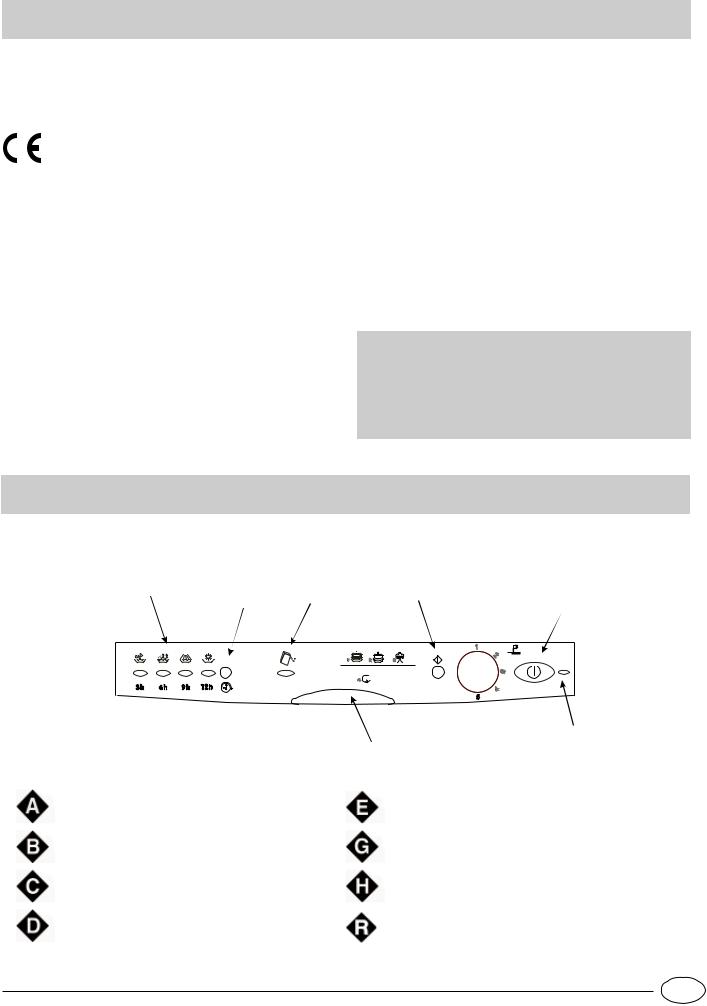
La sicurezza, una buona abitudine
ATTENZIONE
Leggete attentamente le avvertenze contenute nel presente libretto in quanto forniscono importanti indicazioni riguardanti la sicurezza di installazione, d’uso e di manutenzione.
Questa apparecchiatura è conforme alle seguenti Direttive Comunitarie:
-73/23/CEE (Basse Tensioni) e successive modificazioni;
-89/336/CEE (Compatibilità Elettromagnetica) e successive modificazioni.
-97/17 CEE (Etichettatura)
1.Eliminare con cura il materiale dell'imballaggio.
2.Dopo aver tolto l'imballaggio, verificate l'integrità dell'apparecchio. In caso di dubbio, rivolgetevi a personale professionalmente qualificato.
3.La lavastoviglie deve essere usata esclusivamente da adulti e per il lavaggio di stoviglie di uso domestico.
4.Regole fondamentali da seguire nell'uso:
-non toccate la macchina a piedi nudi o con mani o piedi bagnati,
-sconsigliamo di ricorrere a prolunghe e prese multiple,
-durante l'installazione il cavo di alimentazione non deve subire piegature o compressioni rilevanti e pericolose,
-in caso di funzionamento anomalo o di lavori di manuten-
zione disinserire l'apparecchio dalla rete elettrica.
5.I bambini vanno tenuti lontano dai detersivi e dalla lavastoviglie quando é aperta.
6.La macchina non va mai installata all'aperto, nemmeno se lo spazio é riparato da una tettoia, ed é molto pericoloso lasciarla esposta a pioggia e temporali.
7.Non toccate la resistenza durante e subito dopo un ciclo di lavaggio.
8.Non appoggiatevi e non sedetevi sullo sportello aperto, potreste ribaltare la lavastoviglie.
9.In caso di guasto, chiudete il rubinetto di entrata acqua ed estraete la spina dalla presa a muro. Poi provate a consultare il capitolo "C'é qualche problema" e se non trovate una soluzione, contattate il centro assistenza.
10.Gli apparecchi fuori uso devono essere resi inutilizzabili, tagliando il cavo di alimentazione e danneggiando il blocco della porta.
Per garantire l’efficienza e la sicurezza di questo elettrodomestico:
λrivolgetevi esclusivamente a centri di assistenza tecnica autorizzata
λrichiedete sempre l’utilizzo di parti di ricambio originali
Vista da vicino (quadro comandi)
G D
H E R  A
A
Start-Reset
 25
25
5 
|
B |
|
C |
Pulsante ON - OFF |
Spia mancanza sale |
Lampada spia ON - OFF |
Spie fasi avanzamento ciclo e ritardo partenza |
Maniglia apertura porta |
Pulsante selezione ritardo partenza |
Manopola selezione programmi |
Pulsante di "Start/Reset |
1 |
IT |
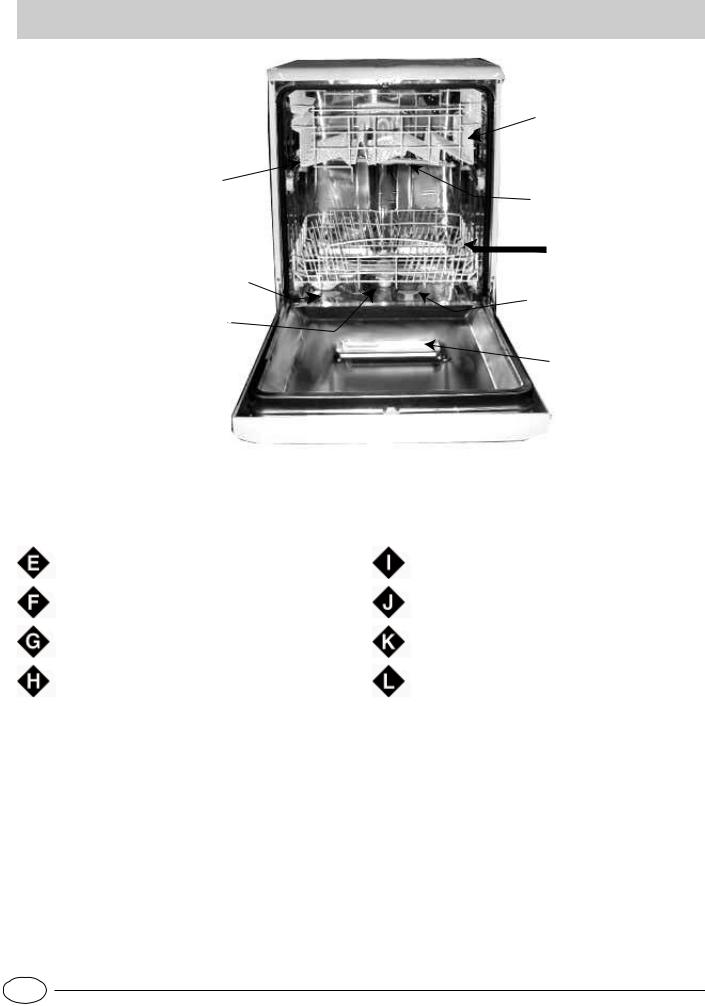
Vista da vicino (Interno)
E
G
F
H
J
K
I
L
Cestello superiore |
Irroratore inferiore |
|
|
|
Irroratore superiore |
Tappo contenitore sale |
|
|
|
Regolazione altezza cestello |
Filtro lavaggio |
|
|
|
Cestello inferiore |
Contenitore detersivo e brillantante |
|||
|
|
|
|
|
|
Caratteristiche tecniche |
|
|
|
|
|
|
|
|
|
Larghezza |
cm. 60 |
||
|
|
|
|
|
|
Profondità |
cm. |
60 |
|
|
|
|
|
|
|
Altezza |
cm. |
85 |
|
|
|
|
|
|
|
Capacità |
12 coperti standard |
||
|
|
|
|
|
|
Pressione acqua alimentazione |
30 KPa÷1MPa (0,3 ÷10 bar) |
||
|
|
|
|
|
|
Tensione di alimentazione |
Vedi targhetta caratteristiche |
||
|
|
|
|
|
|
Potenza totale assorbita |
Vedi targhetta caratteristiche |
||
|
|
|
|
|
|
Fusibile |
Vedi targhetta caratteristiche |
||
|
|
|
|
|
IT |
2 |
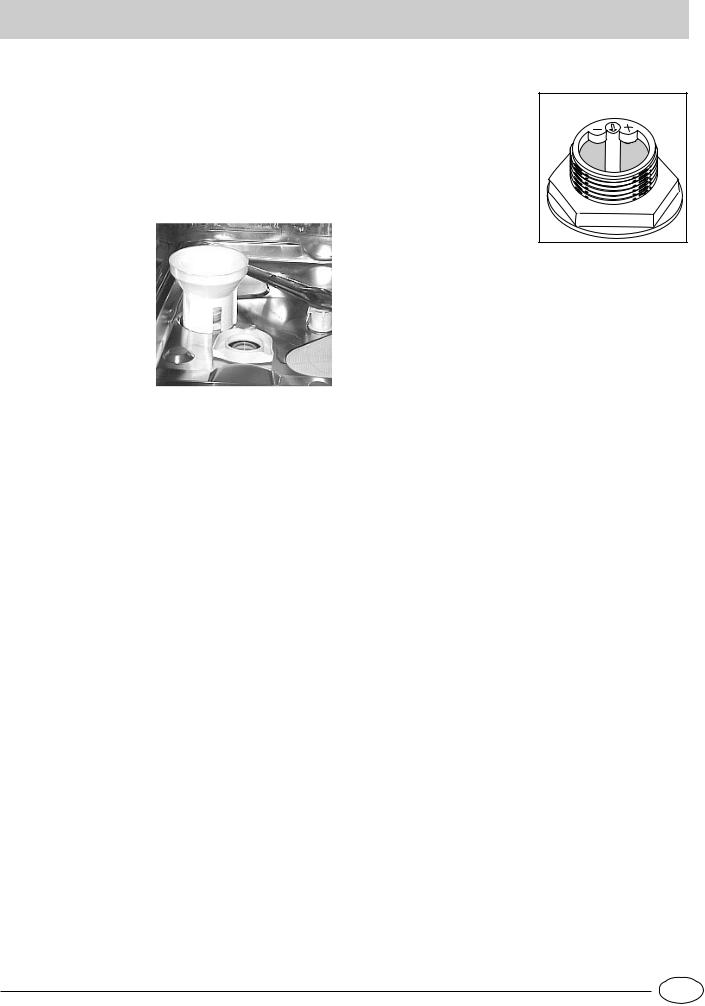
Sale ....
Il sale
La durezza dell'acqua varia a seconda della località. Se nella lavastoviglie entrasse acqua dura, si formerebbero incrostazioni sulle stoviglie.
Grazie ad un decalcificatore che utilizza sale specifico per lavastoviglie, si elimina il calcare dall'acqua.
Caricamento del sale nel decalcificatore
Utilizzate sempre sale specifico per lavastoviglie. Il serbatoio del sale é sotto
il cestello inferiore e va riempito così:
1.Estraete il cesto inferiore, svitate e togliete il tappo del serbatoio.
2.Se state caricando il serbatoio per la prima volta, riempitelo d'acqua.
3.Mettete l'imbuto in dotazione sul foro ed introducete circa 2 Kg di sale. E' normale che un po' d'acqua fuoriesca dal serbatoio.
4.Riavvitate il tappo con cura.
l serbatoio del sale va riempito quando lampeggia la spia mancanza sale “E” .Dopo aver caricato il sale per la prima volta, è normale che la spia lampeggi per circa 5 cicli consecutivi.
Attenzione: Per evitare la formazione di ruggine consigliamo di caricare il sale prima di iniziare un ciclo di lavaggio.
Regolazione consumo sale
La lavastoviglie è predisposta per la regolazione del consumo di sale in funzione della durez-
za dell'acqua che si utilizza in modo da ottimizzare e personalizzare il consumo del
sale al livello minimo necessario.
Potete richiedere il grado di durezza dell’acqua all’Ente erogatore dell’acqua potabile della vostra zona.
Per la regolazione seguire le seguenti istruzioni:
1.svitare il tappo del serbatoio sale
2.sul collare del serbatoio è posta una freccia (vedi fig. accanto) ruotare, se necessario, la freccia dal segno "-" in senso antiorario verso il segno "+" a seconda della durezza dell'acqua di alimentazione.
Si consiglia di effettuare la regolazione secondo lo schema seguente:
Durezza dell’acqua |
|
|
|
||
|
|
|
|
|
|
|
|
|
|
Consumo |
|
°dH |
°fH |
mmol/l |
Posizione |
sale |
Autonomia |
|
|
|
selettore |
(grammi/- |
(cicli\2kg) |
|
|
|
|
ciclo) |
|
|
|
|
|
|
|
0 -10 |
0 - 17 |
0 - 1,7 |
/ |
0 |
/ |
|
|
|
|
|
|
10 - 25 |
18 - 44 |
1,8 - 4,4 |
- |
20 |
60 |
|
|
|
|
|
|
25 - 50 |
45 - 89 |
4,5 - 8,9 |
MED |
40 |
40 |
|
|
|
|
|
|
> 50 |
> 89 |
> 8,9 |
+ |
60 |
25 |
|
|
|
|
|
|
3 |
IT |
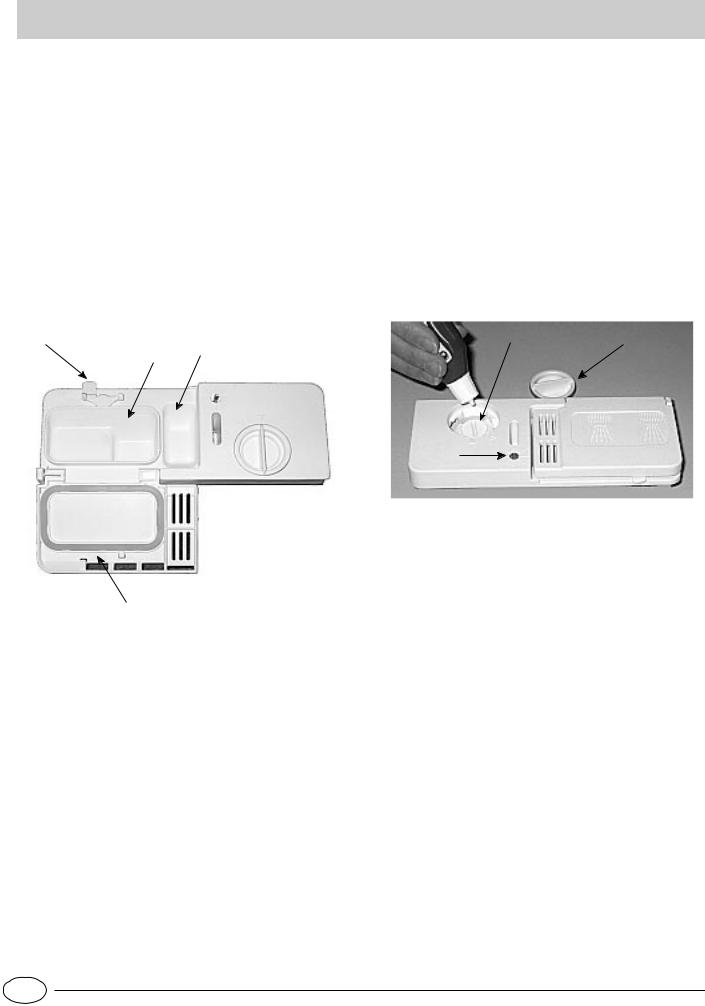
Detersivo e brillantante .....
Il detersivo
Usare solamente detersivo specifico per lavastoviglie. Il rifornimento del detersivo deve essere effettuato prima dell'inizio di ogni ciclo di lavaggio sulla base delle indicazioni fornite nella "Tabella cicli di lavaggio". Il distributore del detersivo si trova all'interno della porta.
Caricamento del detersivo
Per aprire il coperchio "A" premere il pulsante "B". Il detersivo va inserito nelle 2 vaschette "C" e "D" fino al bordo. Dopo aver versato il detersivo chiudere il coperchio, premendolo fino allo scatto.
In commercio si può trovare del detersivo per lavastoviglie in compresse, in questo caso mettere una compressa nella vaschetta "D" e chiudere il coperchio.
Il brillantante
Il brillantante rende le tue stoviglie più brillanti perché ne migliora l’asciugatura. Il serbatoio del brillantante è posto all’interno della porta. Dovrai riempirlo quando vedi il serbatoio vuoto attraverso la spia ottica “D”.
(Se la tua lavastoviglie è provvista di “spia mancanza brillantante”, lo riempirai quando lampeggia o si illumina).
Caricamento del brillantante
Per aprire il contenitore occorre ruotare in senso antiorario il tappo "C" e quando versate il brillantante evitate che questo fuoriesca. E' possibile regolare la quantità di prodotto erogata, agendo con un cacciavite sul regolatore "F" posto sotto il coperchio "C". Vi sono 6 posizioni possibili, normalmente é tarato sul 4.
B F C
D
C
25 gr. |
5 gr. |
A
Per facilitare l'aggancio del coperchio, eliminate, prima della chiusura, eventuali residui di detersivo caduti sui bordi della vaschetta.
D
Importante:
La regolazione dell'erogazione del brillantante permette di migliorare l'asciugatura.
Se sulle stoviglie lavate rimanessero gocce d'acqua o macchie, è necessario ruotare il regolatore verso i numeri più alti. Se le stoviglie lavate presentassero delle striature bianche, ruotare il regolatore verso i numeri più bassi.
Attenzione
In commercio puoi trovare prodotti per il lavaggio delle stoviglie che contengono detersivo, sale e brillantante (3 in 1). Se la tua acqua è dura o molto dura ti consigliamo di aggiungere comunque sale nell’apposito dispenser, per evitare la formazione di striature bianche sulle stoviglie o sulla vasca.
Aggiungi il brillantante nel serbatoio solo se l’asciugatura delle stoviglie non è soddisfacente. In ogni caso consulta attentamente le istruzioni del produttore sulle confezioni.
IT |
4 |
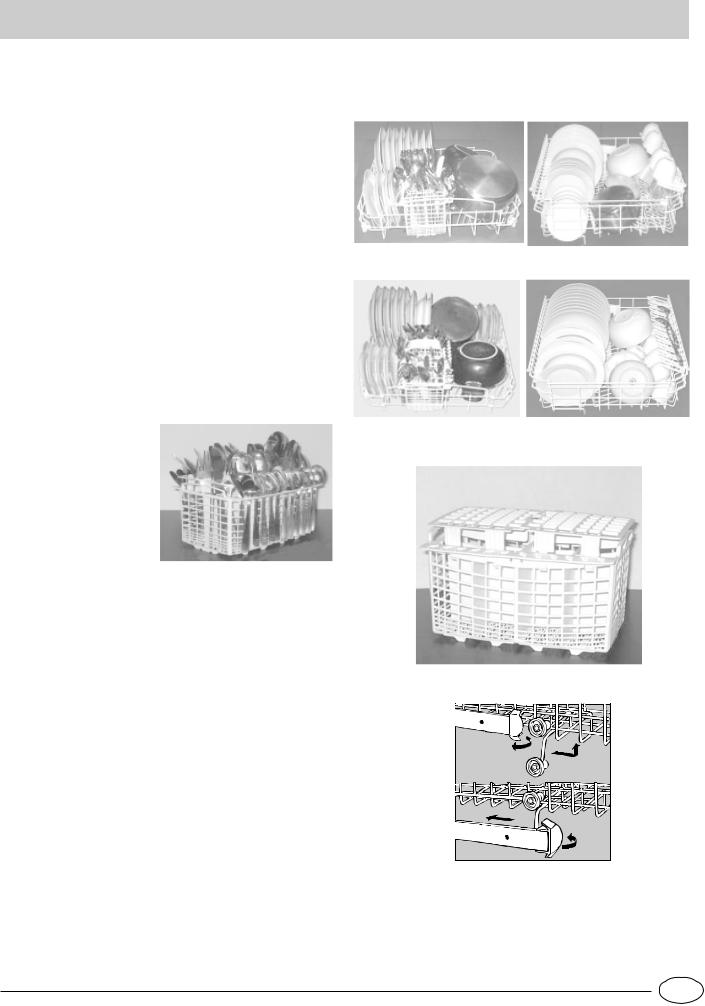
Caricamento delle stoviglie
Prima di disporre le stoviglie nei cestelli, asportate i residui più grossi di cibo per evitare di intasare i filtri con conseguente riduzione dell'efficacia di lavaggio.
Qualora le pentole e le padelle fossero molto incrostate, vi consigliamo di metterle a bagno in attesa del lavaggio. Si eviteranno così ulteriori lavaggi.
Estrarre i cesti per facilitarel'operazione di carico delle stoviglie.
Come utilizzare il cestello inferiore
Nel cestello inferiore vi consigliamo di mettere le stoviglie più difficili:
pentole, coperchi, piatti piani e fondi come indicato nelle figure a lato.
I piatti da portata e coperchi grandi vanno sistemati di preferenza ai lati del cesto, senza però bloccare la rotazione dell'irroratore superiore.
-pentole, insalatiere etc. devono essere sempre capovolte
-stoviglie molto fonde vanno sistemate in posizione obliqua, onde consentire all'acqua di defluire.
Inserisci le posate nel cestino:i coltelli e gli utensili con punte taglienti devono
essere caricati con le A punte in basso.
Sistema tutte le posate in modo che non si tocchino fra di loro.
Se il cestino è dotato di inserti laterali i cucchiaini vanno inseriti singolarmente nelle apposite feritoie (ved. fig. A).
Posate particolarmente lunghe vanno sistemate in posizione orizzontale nella parte anteriore del cestello superiore.
Come utilizzare il cestello superiore
Il cestello superiore è adatto a contenere stoviglie delicate e leggere come bicchieri, tazze da the e caffè, piattini, ma anche piatti, insalatiere basse, padelle e tegami bassi poco sporchi.
- Collocare le stoviglie leggere in modo che non vengano spostate dai getti d’acqua.
Come regolare il cestello superiore.
E’ possibile regolare il cestello superiore in posizione alta o bassa. Per fare ciò aprire le alette di arresto rotaie e sfilare il cestello; sistemarlo con le rotelle posteriori in posizione alta o bassa quindi farlo scivolare lungo le guide fino a far entrare anche le rotelle anteriori; richiudere le alette per l'arresto (vedi figura F).
Esempi di caricamenti
Cesto inferiore |
Cesto superiore |
A
|
1 |
2 |
|
|
|
Fig. F |
|
3 |
|
4 |
|
|
|
5 |
IT |

Come avviare la macchina
Come avviare un programma di lavaggio....
Dopo aver effettuato tutte le operazioni riportate nei capitoli precedenti ed aver aperto completamente il rubinetto del- l’acqua, premete il pulsante ON-OFF “A” posto sul quadro comandi; la spia “B” si illumina.
A questo punto la lavastoviglie è sotto tensione e potete scegliere il programma di lavaggio.
Avviamento e selezione del programma.
Ruotate in senso orario la manopola di selezione programmi"D" fino a far coincidere la tacchetta di riferimento sulla manopola con il numero o il simbolo del ciclo che si desidera impostare (consultate specie nei primi tempi la tabella programmi a pag.7).
Se la porta è chiusa, premendo il pulsante di Start “R” sentite un segnale acustico ed entro pochi secondi il programma si avvia.
Lampade spia avanzamento ciclo
La lavastoviglie è dotata di 4 lampade spia "G" che si illuminano in successione quando la macchina sta eseguendo quella fase del programma .
Queste fasi sono:
prelavaggio, lavaggio, risciacqui, asciugatura
Annullare o modificare un programma in corso.....
Premessa: Potete annullare un programma in corso solo se è iniziato da poco.
Per modificare un programma tenete premuto per circa 5 secondi il pulsante di RESET “R”: sentirete un segnale acustico prolungato seguito da 3 brevi bip. La spia “G”si spegne e a questo punto tutte le impostazioni sono state annullate. Per selezionare un nuovo programma ripetete le operazioni previste nel paragrafo “avviamento e selezione del programma”.
Attenzione: la manopola deve essere ruotata in senso orario dal programma 1 al programma 5, antiorario dal programma 5 al programma 1.
Nel caso in cui abbiate dimenticato di inserire una stoviglia...
E' possibile interrompere il ciclo di lavaggio premendo il pulsante ONOFF , quindi inserire le stoviglie ed all'accensione della macchina il ciclo riprenderà dal punto in cui era stato interrotto.
E' andata via la luce? Avete aperto la porta della macchina?
Il programma si interrompe e poi riprende quando torna la luce o alla chiusura della porta.
Alla fine del lavaggio....
La fine del ciclo è segnalata da 2 brevi segnali acustici e dal lampeggiare della spia relativa all’asciugatura.
•Spegnete la macchina premendo il pulsante “A” .
•Chiudete il rubinetto dell’acqua.
•Attendete alcuni minuti prima di togliere le stoviglie:se aspettate un pochino, con il vapore si asciugano meglio.
•Svuotate per primo il cesto inferiore.
Avvertenza: quando aprite la porta della lavastoviglie, se il ciclo di lavaggio è in corso o è appena terminato, fate attenzione al vapore caldo che fuoriesce, potreste scottarvi.
Decidi tu quando partire.
Hai caricato la lavastoviglie, prima di impostare il programma migliore puoi scegliere anche quando farla partire. Premi il tasto “H” e puoi posticipare la partenza del ciclo di lavaggio di 12, 9, 6 e 3 ore. Ad ogni pressione senti un segnale acustico e vedi accendersi la spia “G” corrispondente al ritardo selezionato.
Ora puoi scegliere il programma che desideri e dopo il segnale acustico inizierà il conto alla rovescia del tempo di attesa.
Se ad esempio hai impostato il ritardo partenza di 12 ore, dopo aver scelto il programma vedrai lampeggiare la spia 12 ore, poi lampeggeranno via via le altre spie fino alla scadenza del ritardo programmato. Saprai sempre con un’occhiata a che punto è il conto alla rovescia.
Doppia funzione delle spie “G”
1)lampeggia in corrispondenza del ritardo partenza: ti ricorda che hai impostato la partenza differita
2)rimane accesa senza lampeggiare sotto al simbolo della fase:
significa che il programma si è avviato e sta svolgendo la fase indicata dal simbolo stesso.
Hai cambiato idea?
Se cambi idea, puoi impostare un ritardo partenza inferiore: premi il pulsante “H” per selezionarlo. Non occorre resettare il programma.
Se invece vuoi annullare il ritardo impostato e desideri avviare subito il programma, premi il pulsante “H” in successione fino a quando il ciclo si avvia e la spia “G” si accende in corrispondenza della fase di inizio del programma.
IT |
6 |

Tabella programmi
Con il lavaggio in lavastoviglie avrete la garanzia di un ambiente igienizzante e di un pulito più sicuro.
|
,QGLFD]LRQL SHU OD |
'HVFUL]LRQH |
|
'HWHUVLYR |
|
'XUDWD GHO |
|
|
|
SURJUDPPD |
|||
3URJUDPPD |
VFHOWD GHL |
|
SUHODYDJJLR |
%ULOODQWDQWH |
||
GHO FLFOR |
|
WROOHUDQ]D |
||||
|
SURJUDPPL |
|
ODYDJJLR |
|
||
|
|
|
|
“ |
||
|
|
|
|
|
||
|
|
|
|
|
|
|
|
Stoviglie e pentole |
Prelavaggio con acqua calda |
a 40°C |
|
|
|
|
Lavaggio prolungato a 65°C. |
|
|
|
|
|
|
molto sporche (da non |
|
JU |
|
|
|
|
usare per pezzi |
2 Risciacqui con acqua fredda |
|
|||
|
Risciacquo caldo a 65°C |
|
||||
|
delicati). |
|
|
|
|
|
|
Asciugatura. |
|
|
|
|
|
|
|
|
|
|
|
|
(QHUJLFR |
|
|
|
|
|
|
|
|
|
|
|
|
|
|
Stoviglie e pentole |
Prelavaggio con acqua fredda |
|
|
|
|
|
Lavaggio prolungato a 50°C. |
|
|
|
|
|
|
normalmente sporche. |
|
JU |
|
|
|
|
Risciacquo freddo |
|
||||
|
Ciclo standard |
|
||||
|
Risciacquo caldo a 70°C |
|
||||
|
giornaliero. |
|
|
|
|
|
5DSLGR |
Asciugatura. |
|
|
|
|
|
|
|
|
|
|
||
|
|
|
|
|
|
|
4XRWLGLDQR |
|
|
|
|
|
|
|
|
|
|
|
|
|
|
Programma per un |
|
|
|
|
|
|
lavaggio ecologico, a |
2 Prelavaggi con acqua fredda |
|
|
|
|
|
bassi consumi |
Lavaggio prolungato a 50°C |
|
JU |
|
|
|
energetici, adatto a |
Risciacquo caldo a 65°C |
|
|||
|
stoviglie e pentole |
Asciugatura |
|
|
|
|
(FR |
normalmente sporche. |
|
|
|
|
|
|
|
|
|
|
|
|
|
Ciclo economico e |
|
|
|
|
|
|
veloce da utilizzare per |
Breve lavaggio a 50°C |
|
JU |
|
|
|
stoviglie poco sporche |
Risciacquo a 50°C |
|
|
|
|
|
subito dopo l'uso. |
|
|
|
|
|
|
|
|
|
|
|
|
5DSLGR |
Senza asciugatura. |
|
|
|
|
|
|
|
|
|
|
|
|
|
Lavaggio preliminare |
|
|
|
|
|
|
di pentole e stoviglie in |
Breve lavaggio freddo per impedire |
|
|
|
|
|
attesa di completare il |
l'essicazione dei residui di cibo sulle |
|
|
||
|
carico al pasto |
stoviglie. |
|
|
|
|
$PPROOR |
successivo. |
|
|
|
|
|
|
|
|
|
|
|
|
|
|
|
|
|
|
|
7 |
IT |

Consigli per risparmiare
-E' importante attivare la lavastoviglie possibilmente a pieno carico per ottimizzare i consumi; per evitare che nel frattempo si formino cattivi odori e incrostazioni, potete utilizzare il ciclo ammollo.
-Scegliete il programma adeguato : la scelta del programma dipende dal tipo di stoviglie da lavare e dal loro grado di sporco.
-Dosate la giusta quantità di detersivo: se eccedete con il quantitativo di detersivo non otterrete stoviglie più pulite, ma solamente un maggiore impatto ambientale.
-E' inutile sciacquare le stoviglie prima di posizionarle nella macchina.
Come tenere in forma la lavastoviglie
Dopo ogni lavaggio
Dopo ogni lavaggio chiudete il rubinetto dell'acqua e lasciate socchiusa la porta in modo che non ristagnino nè umidità, nè cattivi odori.
Staccare la spina
Prima di fare qualsiasi pulizia o manutenzione, staccate sempre la spina dalla presa: in questo modo non correrete alcun pericolo.
Niente solventi nè abrasivi
Per pulire l'esterno e le parti in gomma della lavastoviglie non occorre usare nè solventi nè abrasivi ma solo un panno imbevuto di acqua tiepida e sapone.
Per eliminare eventuali macchie sulla superfice della vasca, utilizzare un panno imbevuto di acqua ed un po' di aceto bianco o prodotto specifico per la pulizia della lavastoviglie.
Se partite per le vacanze
Quando andate in vacanza, é consigliabile fare un lavaggio a vuoto, dopodichè staccare la spina, chiudere il rubinetto di ingresso acqua e lasciare socchiusa la porta: le guarnizioni dureranno più a lungo ed all'interno non si formeranno odori sgradevoli.
In caso di trasloco
In caso di trasloco possibilmente mantenete l'apparecchio in posizione verticale; se fosse necessario, inclinatela sul lato posteriore.
Le guarnizioni.
Uno dei fattori responsabili del ristagno di odori all'interno della lavastoviglie é rappresentato dai residui di cibo che rimangono nelle guarnizioni. Basterà pulirle periodicamente con una spugnetta inumidita.
IT |
8 |
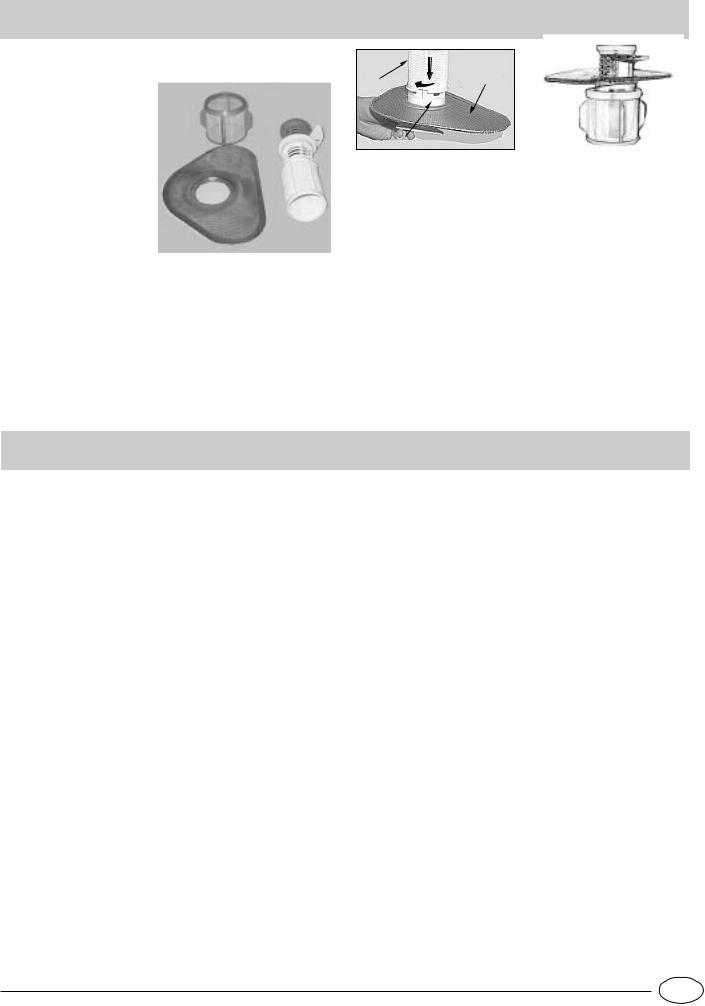
Pulizia e manutenzioni particolari
Il gruppo filtrante |
|
|
Per avere sempre buoni ri- |
|
|
sultati di lavaggio, è neces- |
|
|
sario pulire il gruppo filtran- |
|
|
te. |
|
|
L’acqua di lavaggio viene |
D |
|
pulita dai residui di cibo e |
C |
|
|
||
rimessa in circolo perfetta- |
|
|
mente filtrata. Per questo, |
|
|
dopo ogni lavaggio, è me- |
B |
|
glio rimuovere i residui più |
||
A |
||
grossi che trovi trattenuti |
||
|
||
dal filtro semicircolare A e |
|
|
dal bicchiere “C”; per |
|
estrarli tirare il manico del bicchere verso l’alto. Basterà sciacquarli sotto l’acqua corrente.
Una volta al mese è necessario pulire accuratamente tutto il gruppo filtrante: filtro semicircolare A +bicchiere C + filtro cilindrico B+ microfiltro D.
Il filtro “B” si estrae ruotandolo in senso antiorario.Per la pulizia aiutarsi con uno spazzolino non metallico. Rimettere insieme i pezzi (come indicato nella figura) e reinserire il gruppo nella lavastoviglie. Posizionarlo nel suo
|
1 |
|
B |
2 |
A |
C
alloggiamento facendo una pressione verso il basso.
La lavastoviglie non deve essere usata senza filtri. Se i filtri non sono inseriti correttamente si ridurrà l’efficacia di lavaggio, e si potrebbe anche danneggiare la lavastoviglie.
Pulizia degli irroratori
Può succedere che residui di cibo si attacchino agli irroratori ostruendo i fori; controllarli periodicamente e pulirli (vedere Vista di vicino (interno) alle lettere F-I).
Pulizia del filtro entrata acqua
Pulire periodicamente il filtro entrata acqua (ved. figura 2) posto all'uscita del rubinetto.
Dopo aver chiuso il rubinetto svitare l'estremità del tubo di carico acqua, togliere il filtro e pulirlo delicatamente sotto un getto di acqua corrente; inserire, quindi, nuovamente il filtro e riavvitare il tubo.
C'é qualche problema ?
Può accadere che la lavastoviglie non funzioni o non funzioni bene. Prima di chiamare l'assistenza, vediamo insieme cosa si può fare: può darsi che abbiate dimenticato di premere qualche tasto o non abbiate fatto, per distrazione, una manovra necessaria affinchè la macchina funzioni.
La lavastoviglie non parte
Avete controllato se:
il rubinetto è aperto e ben collegato al tubo, manca l'acqua in casa oppure non arriva con sufficiente pressione, il tubo è piegato, il filtro del tubo di alimentazione acqua è intasato, la porta è aperta.
Le stoviglie non sono pulite
Avete controllato se:
è stata messa la giusta dose di detersivo, il programma di lavaggio selezionato è idoneo alle stoviglie da lavare, filtro e microfiltro sono puliti, gli irroratori sono liberi.
La lavastoviglie non scarica
Avete controllato se:
il tubo di scarico è piegato.
Sulle lavastoviglie rimangono depositi calcarei o una patina bianca
Avete controllato se:
il tappo del contenitore sale è chiuso bene, il dosaggio di brillantante è regolato bene.
Messaggi di errore
La lavastoviglie è dotata di un sistema di sicurezza in grado di rilevare eventuali anomalie di funzionamento. Tali anomalie sono segnalate da una o due spie ciclo “G” lampeggianti a frequenza rapida. Dopo aver preso nota di quali spie lampeggiano spegnete la macchina e chiamate l’assistenza tecnica.
Allarme rubinetto chiuso
Se avete dimenticato di aprire il rubinetto dell’acqua, l'apparecchio lo segnala per alcuni minuti con brevi segnali acustici. Aprite il rubinetto e vedrete che la macchina, dopo alcuni minuti, si riavvia. Nel caso in cui non siete presenti quando vengono emessi i segnali acustici, la macchina si blocca e le spie 2 e 3 (lavaggio e risciacqui) lampeggiano a frequenza rapida. Spegnete con il pulsante di OnOff, aprite il rubinetto dell’acqua e dopo aver atteso circa 20 secondi riaccendete la macchina; riselezionate il programma come previsto nel paragrafo “Scegliere il programma”e vedrete che la macchina si avvia.
Allarme filtri intasati
Se la macchina è bloccata e lampeggiano a frequenza rapida le spie1(prelavaggio) e 3 (risciacqui)) significa che il filtro è intasato da massicci residui di cibo. Spegnete la macchina, pulite accuratamente il filtro e dopo averlo risistemato nella sua sede riaccendete. Riselezionate Il programma ed esso si avvierà regolarmente.
Se invece lampeggiano a frequenza rapida spie diverse da quelle sopra indicate, spegnete la macchina e chiamate l'assistenza tecnica.
Se nonostante tutti i controlli, la lavastoviglie non funziona e l'inconveniente da voi rilevato continua ad esserci, chiamate il centro assistenza autorizzato più vicino, comunicando le seguenti informazioni:
-il tipo di guasto
-la sigla del modello (Mod. ....) ed il numero di serie(S/N
....) riportati sulla targhetta applicata nella parte laterale delle controporta.
Non ricorrete mai a tecnici non autorizzati e rifiutate sempre l'installazione di pezzi di ricambio non originali.
9 |
IT |
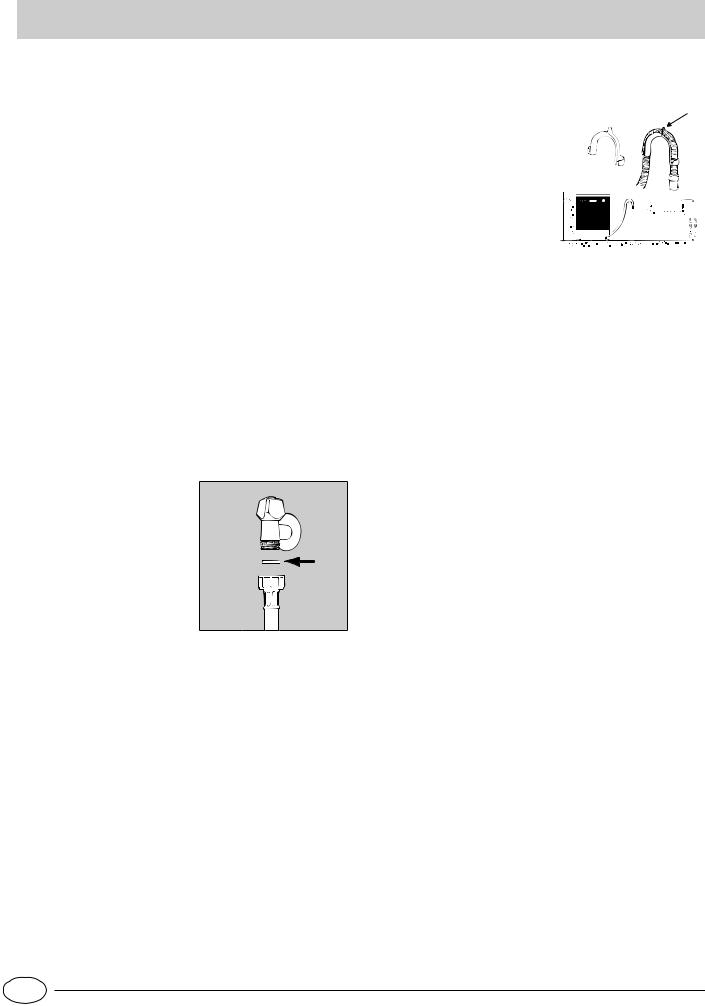
Installazione
Posizionamento
Sistemare la macchina nel punto prescelto. La macchina può essere fatta aderire con i fianchi o con lo schienale ai mobili adiacenti o alla parete. La lavastoviglie é munita di tubi per l'alimentazione e lo scarico dell'acqua che possono essere orientati verso destra o verso sinistra per consentire un'adeguata installazione.
Livellamento
Posizionare la macchina agire sui piedini avvitandoli e svitandoli al fine di regolare, se necessario, l'altezza della macchina e livellarla in modo che venga a trovarsi orizzontale; non deve comunque, in nessun modo, essere inclinata di oltre 2°.
Un buon livellamento assicurerà il corretto funzionamento
della lavastoviglie.
Questomodellodilavastovigliepuòessereincassatosottoadunpiano dilavorocontinuo(leggereilfogliodiistruzionirelativo).
Collegamento alla presa d'acqua fredda.
L’allacciamento dell’elettrodomestico alla rete idrica deve avvenire esclusivamente con il tubo di carico fornito con l’apparecchio, non utilizzare tubi diversi. In caso di sostituzione utilizzare solo ricambi originali.
Allacciare il tubo di carico ad una presa d'acqua fredda con bocca filettata da 3/4 gas, interponendo il filtrino in dotazio-
ne ed avendo cura di avvitarlo |
|
strettamente al rubinetto (ved. |
|
fig.2) |
|
Se la tubazione dell'acqua é |
|
nuova o é rimasta per lungo |
|
inattiva, prima di fare l'allaccia- |
A |
mento, assicurarsi, facendola |
|
scorrere, che l'acqua diventi lim- |
|
pida e priva di impurità. Senza |
Fig.2 |
questa precauzione c'é il rischio |
|
che l'entrata d'acqua si intasi, |
|
danneggiando la macchina. |
|
Collegamento alla presa d'acqua calda
La macchina può essere alimentata con acqua calda di rete (impianto centralizzato, termosifoni) che non superi la temperatura di 60° C.
In questo caso il tempo di lavaggio sarà abbreviato di circa 15 minuti e l'efficacia del lavaggio lievemente ridotta.
Il collegamento deve essere effettuato alla presa d'acqua calda, con le stesse modalità descritte per il collegamento alla presa d'acqua fredda.
Collegamento al tubo di scarico
Inserire il tubo di scarico in una conduttura di scarico che abbia un diametro minimo di
cm. 4 oppure appoggialo al la- |
|
A |
|||
vandino. Evitare strozzature o |
|
|
|||
curvature eccessive. E' possibi- |
|
|
|||
le metterlo in maniera ottimale |
|
|
|||
utilizzando lo speciale gomito in |
|
|
|||
plastica in dotazione (ved. |
|
|
|||
figura).La parte del tubo contras- |
|
|
|
|
|
|
|
|
|
||
segnata con la lettera A deve |
|
|
|
|
|
essere ad una altezza compre- |
|
|
|||
sa tra 40 e 100 cm. |
|
|
|||
|
|
||||
Il tubo non deve essere immerso nell’acqua. |
|
||||
Attenzione: lo speciale gomito in plastica deve essere fissato saldamente al muro per evitare che il tubo di scarico si muova e non versi l'acqua fuori dallo scarico.
Collegamento elettrico
Inserire la spina in una presa di corrente munita di un efficiente collegamento a terra (la messa a terra dell'impianto é una garanzia di sicurezza prevista dalla legge), dopo aver verificato che i valori della tensione e della frequenza di rete corrispondano a quelli riportati sulla targhetta situata sulla controporta inox della macchina e che l'impianto elettrico al quale essa va collegata sia dimensionato per la corrente massima indicata su tale targhetta. Se la presa di corrente alla quale va collegata la macchina non corrisponde alla spina, sostituire quest'ultima con una spina adatta, piuttosto che impiegare adattatori o derivatori in quanto essi potrebbero provocare riscaldamenti o bruciature.
Si raccomanda, in caso di cavo di alimentazione elettrica danneggiato di rivolgersi, per la sostituzione, esclusivamente ai Centri di Assistenza Tecnica autorizzata.
IT |
10 |
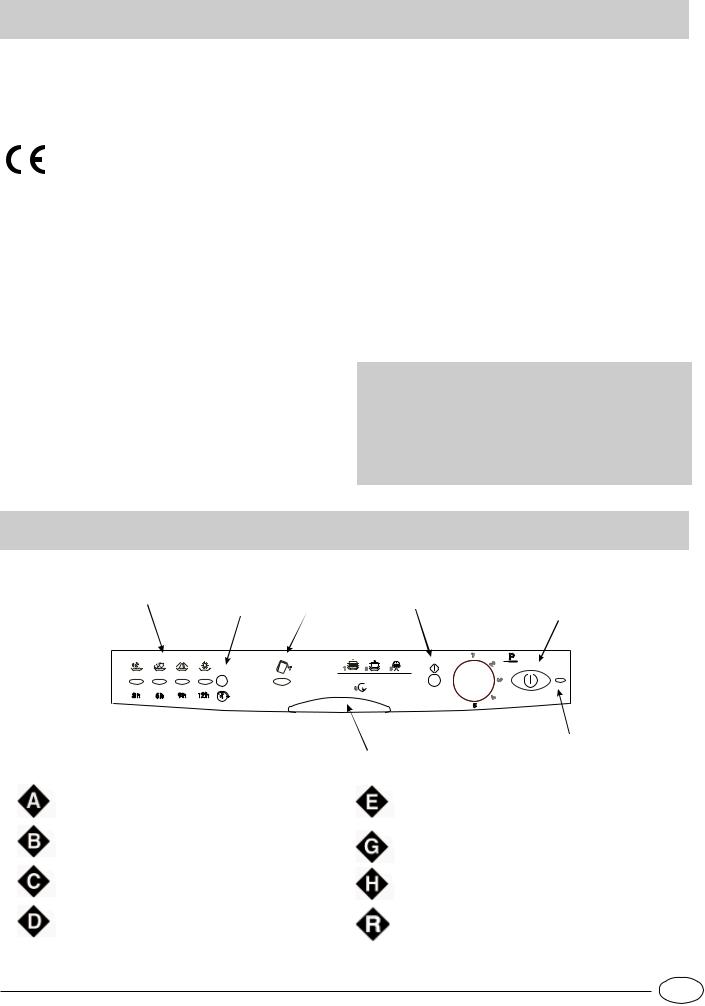
Safety Is a Good Habit to Get Into
NOTICE
Carefully read the instructions contained in this manual, as they provide important information which is essential to safe and proper installation, use and maintenance of the appliance.
This appliance complies with the following EEC directives:
-73/23/EEC of 19/02/73 (Low Voltage) and subsequent modifications;
-89/336/EEC of 03/05/89 (Electromagnetic Compatibility) and subsequent modifications.
-97/17/EEC Labelling
1.Carefully dispose of the packing material.
2.After removing the packing, check to make sure that the appliance is not damaged. If in doubt, contact a qualified professional.
3.The dishwasher must only be used by adults for the washing of household dishes and cooking utensils.
4.Fundamental rules to follow when using the appliance:
-Never touch the dishwasher when barefoot or with wet hands or feet;
-We discourage the use of extension cords and multiple sockets;
-During installation, the power supply cord must not be excessively or dangerously bent or flattened;
-If the appliance is not operating properly or maintenance
must be performed, disconnect the appliance from the power supply.
5.Keep detergents out of the reach of children, who must also be kept away from the dishwasher when it is open. 6.This appliance cannot be installed outdoors, not even if the area in which it is installed is covered by a roof; it is also very dangerous to leave it exposed to the rain and elements. 7.Do not touch the heating element during or after a wash cycle.
8.Do not lean or sit on the door when it is open, as this could overturn the dishwasher.
9.If the appliance malfunctions, turn off water supply to the appliance and disconnect the plug from the wall socket. Then, consult the section entitled, "Troubleshooting." If you cannot resolve the problem, contact a service centre.
10.Appliances which are no longer being used must be made inoperable by cutting the power supply cord and removing the door lock.
To maintain the EFFICIENCY and SAFETY of this appliance, we recommend:
λcall only the Service Centers authorized by the manufacturer
λalways use original Spare Parts
Close-up View (control panel)
G D
H E R  A
A
Start-Reset
 25
25
5 
|
B |
|
C |
ON - OFF Button |
Low salt indicator light |
ON - OFF Light |
Cycle phase and delayed start indicator lights |
Handle For Opening Door |
Delayed start select button |
Knob For Selecting Cycles |
Start/Reset Button |
11 |
GB |
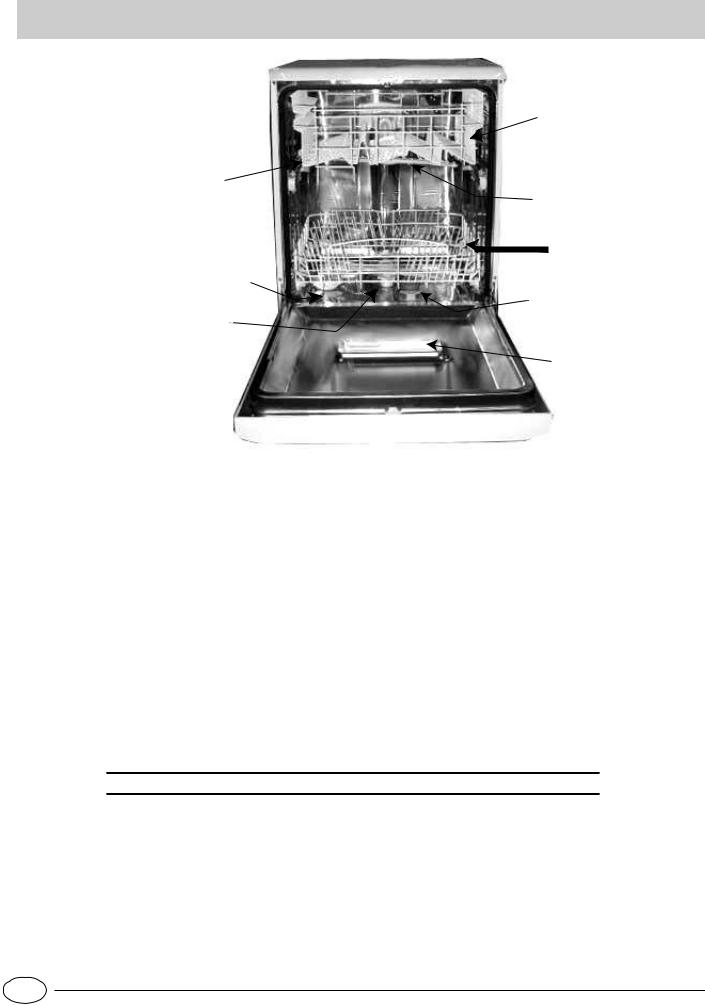
Close-up View (Interior)
G
J
I
 Upper Rack
Upper Rack
 Top Sprayer Arm
Top Sprayer Arm
 Rack Height Adjustor
Rack Height Adjustor
 Lower Rack
Lower Rack
E
F
H
K
L
 Bottom Sprayer Arm
Bottom Sprayer Arm
 Salt Container Cap
Salt Container Cap
 Washing Filter
Washing Filter
 Detergent and Rinse Aid Dispenser
Detergent and Rinse Aid Dispenser
7HFKQLFDO FKDUDFWHULVWLFV
Width |
cm. 60 |
|
Depth |
cm. |
60 |
|
|
|
Height |
cm. |
85 |
Capacity |
12 standard place settings |
|
|
|
|
Mains water pressure |
30 KPa÷ 1MPa (0,3 ÷10 bar) |
|
|
|
|
Power voltage |
See data plate |
|
|
|
|
Total absorber power |
See data plate |
|
|
|
|
Fuse |
See data plate |
|
|
|
|
GB |
12 |
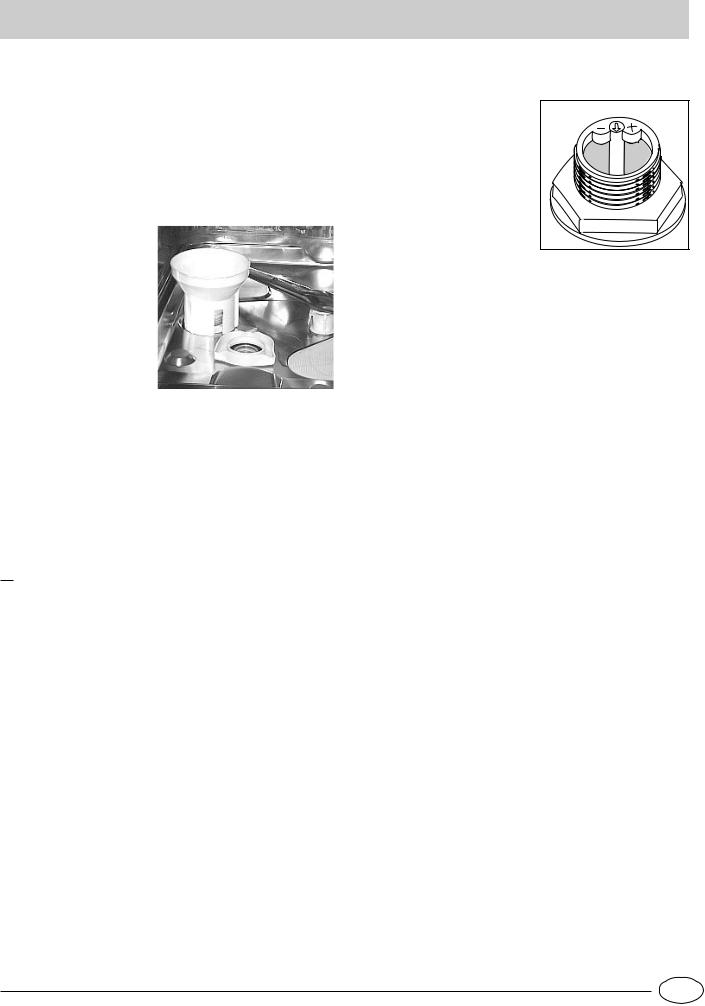
Salt ......
Salt
The hardness of the water varies from place to place. If hard water is used in the dishwasher, deposits will form on the dishes and utensils.
The appliance is equipped with a special softener that uses a salt specifically designed to eliminate lime and minerals from the water.
Loading the Salt into the Softener
Always use salt intended for use with dishwashers. The salt container is located beneath the lower rack and should be filled as follows:
1.Remove the lower rack and then unscrew and remove the cap from the salt container;
2.If you are filling the container for the first time, fill it with water;
3.Place the end of the funnel (supplied) into the hole and introduce about 2 kg of salt. It is normal for a small amount of water to come out of the salt container.
4.Carefully screw the cap back on.
The salt container should be filled up when the low salt indicator light "E" flashes. Once you have loaded the salt for the first time, it is normal that the low salt indicator light stays on or flashes for about 5 consecutive cycles.
Warning: To prevent rust from forming, we advise you to load the salt before starting a wash cycle.
Adjusting Salt Consumption
The dishwasher is designed to allow for adjusting the amount
of salt consumed based on the harness of the water used. This
is intended to optimize and customize the level of salt con-
sumption so that it remains at a minimum.
Your Local Water Board can supply the degree of hardness of the water
in your area.
To adjust salt consumption, proceed as follows:
1)Unscrew the cap from the salt container.
2)There is a ring on the container with an arrow on it (see figure to the side), if necessary, rotate the ring in the anticlockwise direction from the "_" setting towards the "+" sign, based on the hardness of the water being used.
It is recommended that adjustments be made in accordance with the following schema:
:DWHU KDUGQHVV |
|
|
|
|||
|
|
|
|
|
|
|
|
|
|
6HOHFWRU |
6DOW |
$XWRQRP\ |
|
ƒG+ |
ƒI+ |
PPRO O |
NQRE |
FRQVXPSWLRQ |
||
F\FOHV NJ |
||||||
|
|
|
SRVLWLRQ |
JUDPV F\FOH |
||
|
|
|
|
|||
|
|
|
|
|
|
|
0- 10 |
0-17 |
0 -1,7 |
/ |
0 |
/ |
|
|
|
|
|
|
|
|
1025 |
18-44 |
1,8 - 4,4 |
- |
20 |
60 |
|
|
|
|
|
|
|
|
25 - 50 |
45 - 89 |
4,5- 8,9 |
MED |
40 |
40 |
|
|
|
|
|
|
|
|
> 50 |
> 89 |
> 8,9 |
+ |
60 |
25 |
|
|
|
|
|
|
|
|
13 |
GB |
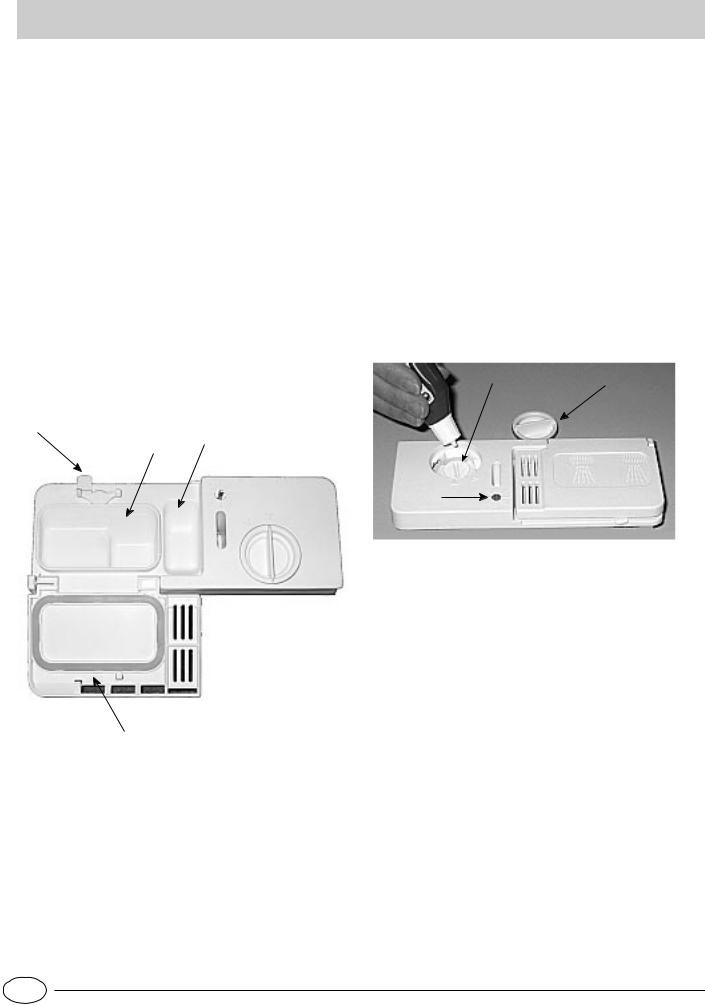
Detergent and Rinse Aid ....
Detergent
Detergent specifically intended for use with dishwashers must be used. The dispenser must be refilled before the start of each wash cycle following the instructions provided in the "Wash Cycle Table." The detergent dispenser is located on the inside panel of the door.
Loading the detergent
To open lid "A", press button "B". The cleaning detergent should be introduced into the two containers "C"and "D" up to the rim.
After pouring in the detergent, replace the lid, pressing down until it clicks.
Dishwasher detergent in tablets is now available on the market, in which case you should place one tablet into container "D" and replace the lid.
Notice: To facilitate closing the cover, remove any excess detergent on the edges of the dispenser.
B C
D
25 gr. |
5 gr. |
Rinse Aid
This product makes dishes sparkle more as it improves their drying. The rinse aid container is situated on the inside of the appliance door; you should refill it when you see the container is empty by means of indicator “D”.
(If your dishwasher is fitted with a “low rinse aid” indicator light, fill the container up when the indicator light flashes or lights up).
Loading the Rinse Aid
To open the dispenser, turn the "C" cap in the anti-clockwise direction and then pour in the rinse aid, making sure not to overfill. The amount of rinse aid used for each cycle can be regulated by turning the "F" dose adjustor, located beneath the "C" cap, with a screwdriver. There are 6 different settings; the normal dosage setting is 4.
F C
D
Important:
Proper dosage of the rinse aid improves drying.
If drops of water remain on the dishes or spotting occurs, the dosage adjustor should be turned to a higher setting. If the dishes have white streaks, turn the dosage adjustor to a lower setting.
A
Warning
Three-in-one dishwasher tablets are now available on the market, and combine the detergent, salt and rinse aid all in one. If the water in your area is hard or very hard, we still recommend you pour extra salt into the relevant dispenser to prevent the formation of white streaks on your dishes or on the appliance interior.
Add rinse aid to the corresponding container only if you are dissatisfied with the results on your dishes. In any case, please read the manufacturer's instructions provided on the packet.
GB |
14 |
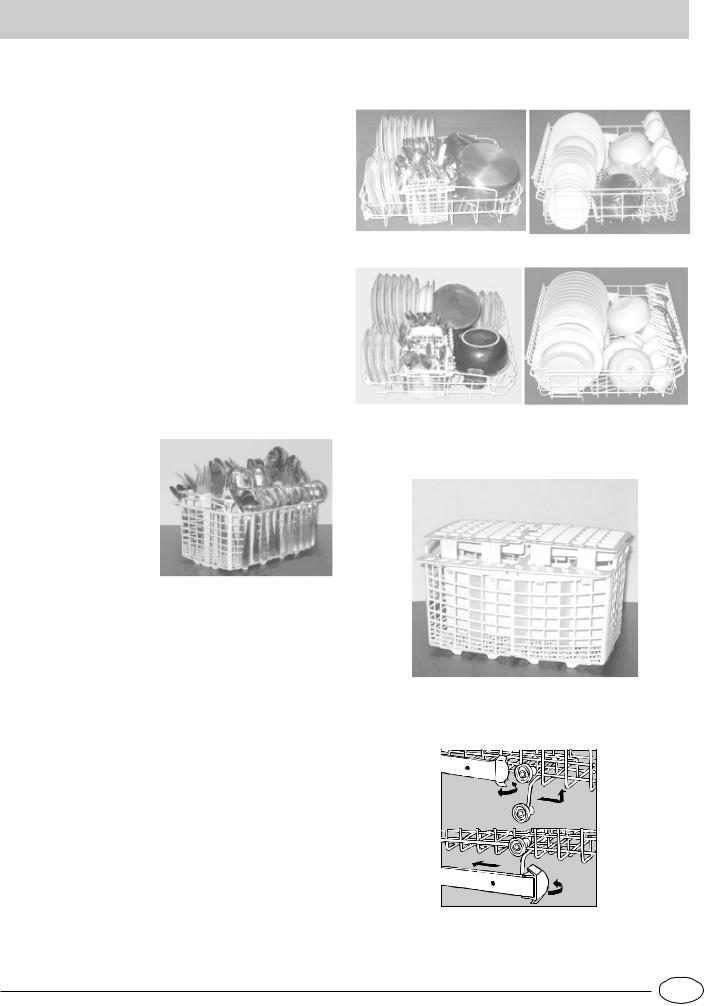
Loading the Dishwasher
Before placing the dishes in the dishwasher, remove the larger food particles to prevent the filter from becoming clogged, which results in reduced performance.
If the pots and pans have baked-on food that is extremely hard to remove, we recommend that they be allowed to soak before they are washed. This will eliminate the need for extra wash cycles.
Pull out the racks to facilitate loading the dishwasher.
How to Use the Lower Rack
We recommend that you place the most difficult to clean items on the bottom rack: pots, pans, lids, serving dishes and bowls, as shown in the figure to the right.
It is preferable to place serving dishes and lids on the sides of the racks in order to avoid blocking the rotation of the top spray arm.
-Pots, serving bowls, etc. must always be placed top down.
-Deep pots should be slanted to allow the water to flow out.
-Insert the cutlery into the basket: knives and utensils with sharp blades or tips should be positioned with the sharp parts at the bottom.
Position all cutlery items so A that they don't touch.
If the rack has side baskets, the spoons should be loaded individually into the appropriate slots (see fig. A).
- Especially long utensils should be placed in the
horizontal position at the front of the upper rack.
How to Use the Upper Rack
The upper rack is designed to hold more delicate and lighter dishware, such as glasses, coffee and tea cups and saucers, as well as plates, small bowls and shallow pans (as long as they are not too dirty).
- Position the dishes and cookware so that they do not get moved by the spray of water.
How to adjust the Upper rack ...
The top rack can be adjusted using the two rack heights (top and bottom). To adjust the rack, open up the tabs that lock the guides and pull out the rack. Arrange the rack with the back wheels in either the top or bottom position and then insert it along the guides until the front wheels are on as well. Close the tabs to lock the rack in place (see Fig. F).
Load examples
Bottom Rack |
Top Rack |
A
|
1 |
2 |
|
|
|
Fig. F |
|
3 |
|
4 |
|
|
|
15 |
GB |

Turning on the Appliance
First of all.
Turn on the water tap completely and press ON-OFF button "A". you will hear a short beep and indicator light "B" lights up.
Now the appliance is on and awaiting instructions.
Starting and selecting the cycle.
Turn the cycle selector knob "D" clockwise until the reference notch on the knob corresponds with the number or symbol for the cycle you wish to set (consult the wash cycle table on page 17, especially when first using the appliance).
If the appliance door is shut, press the Start button "R" and you will hear a beep; the cycle will start up within a few seconds.
Cycle phase indicator lights
The dishwasher is provided with 4 indicator lights "G" which come on in sequence as the appliance is performing that specific phase of the wash cycle.
These phases are:
pre-wash, wash, rinses, drying
Cancelling or modifying a wash cycle in progress…..
Premise: You can cancel the wash cycle in progress, if it has only just started.
To modify a wash cycle, keep the RESET button "R" pressed for about 5 seconds: a prolonged beep will sound, followed by three short beeps. Indicator light "G" will turn off and at this point, all the settings will have been cancelled.
To select a new wash cycle, repeat the operations illustrated in the paragraph entitled "starting and selecting the cycle".
Warning: the knob must be turned clockwise from wash cycle 1 to 5, an anti-clockwise from wash cycle 5 to 1.
If you have left out a dish…
You can interrupt a wash cycle by pressing the ON-OFF button, then place the dishes you had left out into the appliance, which will start up from where it was interrupted when you turn it back on.
There's been a power failure? Have you opened the dishwasher door?
The wash cycle stops and then restarts when the electricity comes back on or when the door is shut.
At the end of the wash cycle….
The end of the wash cycle is indicated by two short beeps and the flashing of the drying phase indicator light.
•Press button "A" to turn the appliance off.
•Turn off the water tap.
•Wait a few minutes before unloading the dishes: if you wait a little while, they dry better thanks to the steam.
•Empty the lower rack first.
Warning: when you open the dishwasher door after the wash cycle has just ended or is under way, take care not to scald yourself with the hot steam.
You decide when it starts.
When you have loaded the dishes, you can choose when to start your dishwasher before setting the wash cycle desired. Press button "H" to delay the start of the wash cycle by 12, 9, 6 or 3 hours. Each time you press it, you will hear a short beep and the indicator light "G" corresponding to the selected delay will come on.
Now you can select the desired wash cycle and, after you hear the beep, the countdown to the delayed start will begin.
If you have set a 12 hour delay, for example, once you have selected the wash cycle, the 12 hour indicator light will flash followed by the others in sequence until the set time delay is up. A quick look at the indicator lights will keep you informed of the countdown progress at all times.
Dual function of indicator lights "G"
1)flashing to indicate a delayed start: to remind you that you have set a delayed start;
2)on and not flashing beneath the cycle phase symbol: meaning the cycle has started and is in the phase indicated by the symbol.
Have you changed your mind?
If you change your mind, you can set a shorter time delay: press button "H" to select it. You need not reset the wash cycle.
If on the other hand you want to cancel the delay set and you want the cycle to start immediately, press button "H" repeatedly until the cycle starts and indicator light "G" corresponding to the cycle start phase comes on.
GB |
16 |

Wash Cycle Table
Dishwasher washing guarantees your dishes will be cleaned in a hygienic setting for safer, cleaner results.
|
|
|
'HWHUJH |
5LQVH |
:DVK F\FOH |
|
&\FOH |
&\FOH VHOHFWLRQ |
&\FOH GHVFULSWLRQ |
QW IRU |
$LG |
GXUDWLRQ |
|
LQVWUXFWLRQV |
SUH ZDVK |
|
WROHUDQFH |
|||
|
|
|
||||
|
|
|
ZDVK |
|
“ |
|
|
|
|
|
|
|
|
|
Very dirty dishes and |
Pre-wash with hot water at 40°C |
|
|
|
|
,QWHQVLYH |
Extended wash at 65°C. |
JU |
|
|
||
pans (not to be used for |
2 cold rinses |
|||||
|
delicate items). |
Rinse with hot water at 65°C. |
|
|
|
|
|
|
Drying. |
|
|
|
|
|
|
|
|
|
|
|
|
Normally dirty pans and |
Pre-wash with cold water. |
|
|
|
|
1RUPDO |
Extended wash at 50°C. |
JU |
|
|
||
dishes. Standard daily |
Cold rinse |
|||||
|
cycle. |
Rinse with hot water at 70°C. |
|
|
|
|
|
|
Drying. |
|
|
|
|
|
|
|
|
|
|
|
|
Environmentally-friendly |
2 Cold pre-washes |
|
|
|
|
|
cycle, with low energy |
|
|
|
||
(FR |
Extended wash at 50°C |
J |
|
|
||
consumption levels, |
||||||
Hot rinse at 65°C |
||||||
|
suitable for normally dirty |
Drying |
|
|
|
|
|
pans and dishes. |
|
|
|
||
|
|
|
|
|
||
|
|
|
|
|
|
|
|
Economic and fast cycle |
|
|
|
|
|
|
to be used for slightly |
Short wash at 50°C. |
|
|
|
|
5DSLG |
dirty dishes. Run cycle |
JU |
|
|
||
Rinse with hot water at 50°C. |
|
|||||
immediately after use. |
|
|||||
|
No drying. |
|
|
|
|
|
|
|
|
|
|
|
|
|
Preliminary wash cycle |
|
|
|
|
|
|
for dishes and pans |
Short cold wash to prevent food |
|
|
|
|
6RDN |
awaiting completion of |
|
|
|
||
from drying onto the dishes. |
|
|
||||
the load with the dishes |
|
|
||||
|
|
|
|
|
||
|
from the next meal. |
|
|
|
|
|
|
|
|
|
|
|
17 |
GB |

Energy Saving Tips
-It is important to try and run the dishwasher when it is fully loaded in order to save on energy. In order to prevent odors from forming and food from caking onto the dishes, you can run the hold cycle.
-Choose the right wash cycle: the choice of cycle depends on the type of dishware, cookware and utensils being washed and how dirty they are.
-Use the right amount of detergent: if you use too much detergent, the result will not be cleaner dishes, but, rather, a greater negative impact on the environment.
-There is no utility in rinsing dishes, cookware and utensils before placing them in the dishwasher.
How to Keep Your Dishwasher in Shape
After Every Wash
After every wash, turn off the water supply to the appliance and leave the door slightly ajar so that moisture and odors are not trapped inside.
Remove the Plug
Before cleaning or performing maintenance, always remove the plug from the socket. Do not run risks.
No Solvents or Abrasive Cleaning Products
To clean the exterior and rubber parts of the dishwasher, do not use solvents or abrasive cleaning products. Rather, use only a cloth and warm soapy water.
To remove spots or stains from the surface of the interior, use a cloth dampened with water and a little white vinegar, or a cleaning product made specifically for dishwashers.
When You Go on Holiday
When you go on holiday, it is recommended that you run a wash cycle with the dishwasher empty and then remove the plug from the socket, turn off the water supply and leave the door of the appliance slightly ajar. This will help the seals last longer and prevent odors from forming within the appliance.
Moving the Appliance
If the appliance must be moved, try to keep it in the vertical position. If absolutely necessary, it can be positioned on its back.
Seals
One of the factors that cause odors to form in the dishwasher is food that remains trapped in the seals. Periodic cleaning with a damp sponge will prevent this from occuring.
GB |
18 |
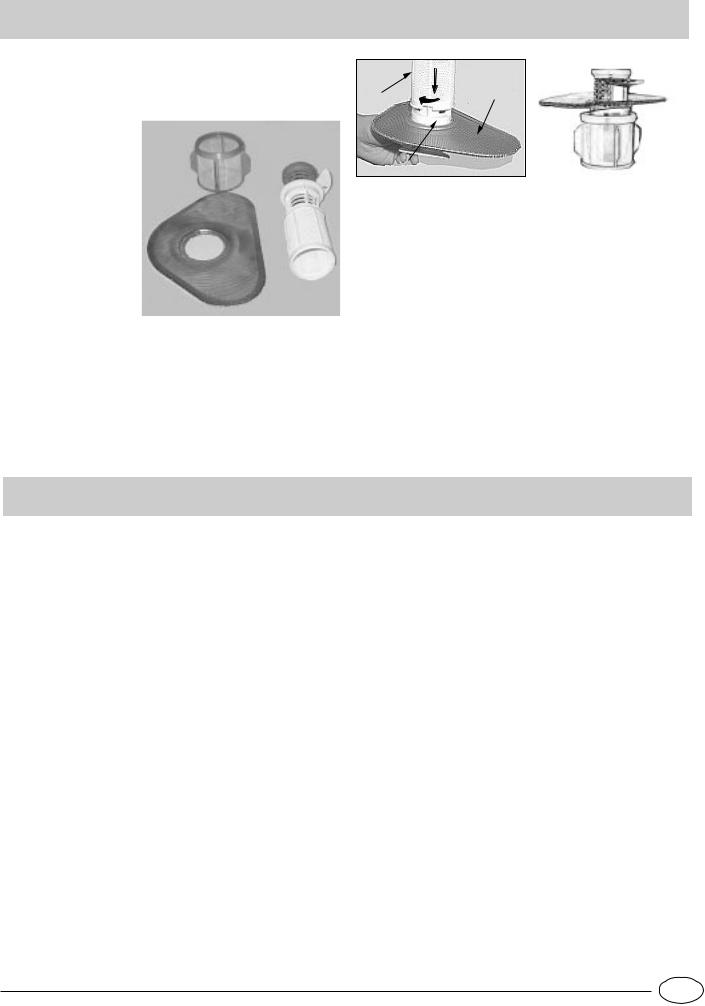
Cleaning and Special Maintenance
The filter assembly
If you want consistent good results from your dishwasher, |
||
you need to clean the filter assembly. |
||
The food particles are |
|
|
removed from the wash |
|
|
water, allowing it to be |
|
|
recirculated during the |
|
|
cycle, filtered perfectly. |
D |
|
For this reason, it is a |
||
C |
||
good idea to remove the |
|
|
larger food particles |
|
|
trapped inside the semi- |
|
|
circular filter A and cup |
B |
|
“C”after each wash; to |
||
remove the filter |
A |
|
assembly, pull the cup handle upwards. All you
need to do is rinse them under running water.
The entire filter assembly should be cleaned thoroughly once a month: semi-circular filter A + cup C + cylindrical filter B+ microfilter D.
To remove filter “B”, turn it anti-clockwise. Use a small nonmetallic brush for cleaning.
Reassemble the filter parts (as shown in the figure) and reinsert the whole assembly into the dishwasher. Position it into its housing and press downwards.
|
1 |
|
B |
2 |
A |
C
The dishwasher is not to be used without filters. Improper replacement of the filters may reduce the efficiency of the wash and even damage your dishwasher.
Cleaning the Sprayer Arms
It may happen that food particle become encrusted on the sprayer arms and block the holes (see "Close up view (interior)", letters F-I). Check the sprayer arms periodically and clean them when needed.
Cleaning the Water Inlet Filter
Periodically clean the water inlet filter (see figure 2 under "Installation") located on the outlet of the water supply tap. After turning off the water tap, unscrew the end of the water supply hose, remove the filter and clean it carefully under running water. Then, return the filter to its place and tighten the water supply hose back into position.
Troubleshooting
It may occur that the dishwasher does not function or does not function properly. Before calling for assistance, let us see what can be done first: have you forgot to press one of the buttons or to perform an essential operation?
The Dishwasher Does Not Start
Have you checked whether:
-the plug is pushed into the socket correctly;
-the power is on in the house;
-the door is closed properly;
-the ON-OFF switch is on "ON";
-the water supply is turned on.
The Dishwasher Does Not Load Water
Have you checked whether:
-the water is turned on and the hose is connected properly;
-the water supply to the house is on and has sufficient pressure;
-the water supply hose is crimped or bent;
-the filter for the water supply hose is clogged.
The Dishes Are Not Clean
Have you put the right amount of detergent into the dispenser? Is the wash cycle suitable for the dishes you have placed inside the appliance?
Are the filter and microfilter clean? Can the sprayer arms turn freely?
The Dishwasher Does Not Drain
Have you checked whether:
- the drain hose is crimped or bent.
Lime Deposits or a White Film Form on the Dishes
Have you checked whether:
-the lid to the salt container is closed properly;
-the rinse aid dosage is correct.
Error messages.
Your dishwasher is equipped with a safety system which is able to detect any operating anomalies. These anomalies are reported by one or two wash cycle indicator lights "G" flashing rapidly.
Take a note of which lights are flashing, turn the appliance off and call for technical assistance.
Tap off alarm
If you have forgotten to turn the water tap on, your appliance will remind you of this by sounding a few short beeps for a few minutes. Turn the tap on and your appliance will start up again after a few minutes. Were you to be absent when these beeps are sounded, the appliance will be blocked automatically and indicator lights 2 and 3 (wash and rinses) will flash rapidly. Turn the appliance off at the ONOFF button, turn on the water tap and wait approximately 20 seconds before turning the appliance back on; repeat the programming operations and the selected wash cycle will start up again.
Clogged filter alarm
If the appliance is blocked and indicator lights 1 (pre-wash) and 3 (rinses) flash rapidly, this means the filter is clogged by large particles of food residue. Turn the appliance off, clean the filter thoroughly and reposition it in its seat as illustrated on this page. Then turn it back on. Repeat the programming operations and the wash cycle will start up again.
If, despite all these checks, the dishwasher still does not function and/or the problem persists, contact the nearest authorised service centre and provide them with the following information:
-the nature of the problem;
-the model type number (Mod. ...) and the serial number (S/N ....), which are indicated on the plate located on the side of the inner part of the door.
Never call on unauthorised technicians and refuse to allow parts to be installed that are not original spare parts.
19 |
GB |
